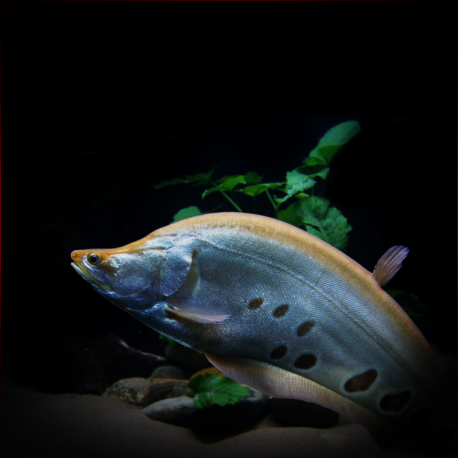More info
Datasheet
| Minimum Tank Size | 10000 litres / 2641.72 US gallons |
| Maximum Size | 100.0cm / 39.37inches |
| Temperature | 20°C / 68.00°F - 28°C / 82.40°F |
| Hardness | 2.02dgH / 36ppm - 15.02dgH / 268ppm |
| pH | 6.0-8.0 |
General Description
The Clown Featherback, also known as Chitala Ornata, belongs to the Osteoglossiformes order and the Notopteridae family. This species is recognized by its one or more rows of large ocellated spots above the base of the anal fin.
Aquarium Setup
For tank setup, the Clown Featherback prefers dim lighting and access to refuges such as driftwood, large rocks, or lengths of plastic piping. A large, mature filter system, weekly water changes of 50-70% tank volume, and highly-oxygenated water with movement are essential. The optimal water conditions include a hardness of 36-268ppm, a pH range of 6.0-8.0, and a temperature between 20-28°C.
Behaviour
The Clown Featherback is generally peaceful towards larger tankmates but can display territorial behavior towards conspecifics and similar-shaped species, especially when space is limited.
Feeding and Diet
As an obligate predator, the Clown Featherback typically feeds on smaller fishes, crustaceans, and invertebrates in the wild but adapts well to dead alternatives in captivity. Young individuals can be fed chironomid larvae, small earthworms, and chopped prawns, while adults accept fish flesh, whole prawns, mussels, live river shrimp, and more. Feeder fish should be avoided due to disease risks.
Reproduction & Dimorphism
In its natural habitat, male Clown Featherbacks construct nests from branches and leaves, guarding the eggs and fry post-spawning. Reproduction in captivity is unreported. Sexual dimorphism is also unreported for this species.
Habitat and Distribution
Native to river systems in Thailand and parts of Southeast Asia, the Clown Featherback is also found in Laos, Cambodia, and Vietnam. It has been introduced to Myanmar, the Philippines, and the USA. This species prefers lower river areas, swamps, floodplains, and lakes. Habitat threats include dam construction and other human-made alterations.

